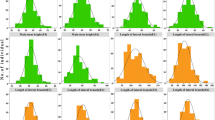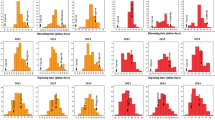Abstract
The objective of this study was to use random amplified polymorphic DNA (RAPD) to determine the genetic location and effects of genomic regions controlling wood density, stem growth and stem form in two species of Eucalyptus. Two hundred F1 trees generated from an interspecific cross E. urophylla×E. grandis between two elite trees were used. Genetic maps were constructed for each parent with markers segregating in the 1:1 ratio in FS progeny. A total of 86 and 92 markers distributed among 11 linkage groups covered 1295 cM and 1312 cM for the E. urophylla and E. grandis parent, respectively. Traits were measured three times up to selection age (38 months). The magnitude of the phenotypic variation explained by the joint action of the segregating quantitative trait alleles indicated that genetic factors of large effect were involved in the control of the studied characters. Several regions controlling part of the variation for the studied traits were identified by interval mapping. Some regions of the genome exerted effects on more than one trait, providing a genetic explanation for at least some of the correlation between the traits. On the basis of an age-by-age analysis, a partial stability of QTL expression was observed with 68% of the QTL being expressed at two ages and 32% being age-specific. No QTL were significant for all three ages. Taking advantage of repeated measurements on the same material across different ages, we investigated with a maximum statistical power, the effect of marker genotype on traits, with age and QTL×age interaction effects being removed. A two-way analysis of variance made it possible to detect significant marker-trait associations over the period studied. Most of them had already been detected in the annual analysis. This result is very encouraging for the application of marker information to the early selection of hybrid trees to be vegetatively propagated for the production of clonal varieties.
Similar content being viewed by others
Author information
Authors and Affiliations
Additional information
Received: 2 December 1996/Accepted: 4 April 1997
Rights and permissions
About this article
Cite this article
Verhaegen, D., Plomion, C., Gion, JM. et al. Quantitative trait dissection analysis in Eucalyptus using RAPD markers: 1. Detection of QTL in interspecific hybrid progeny, stability of QTL expression across different ages. Theor Appl Genet 95, 597–608 (1997). https://doi.org/10.1007/s001220050601
Issue Date:
DOI: https://doi.org/10.1007/s001220050601




